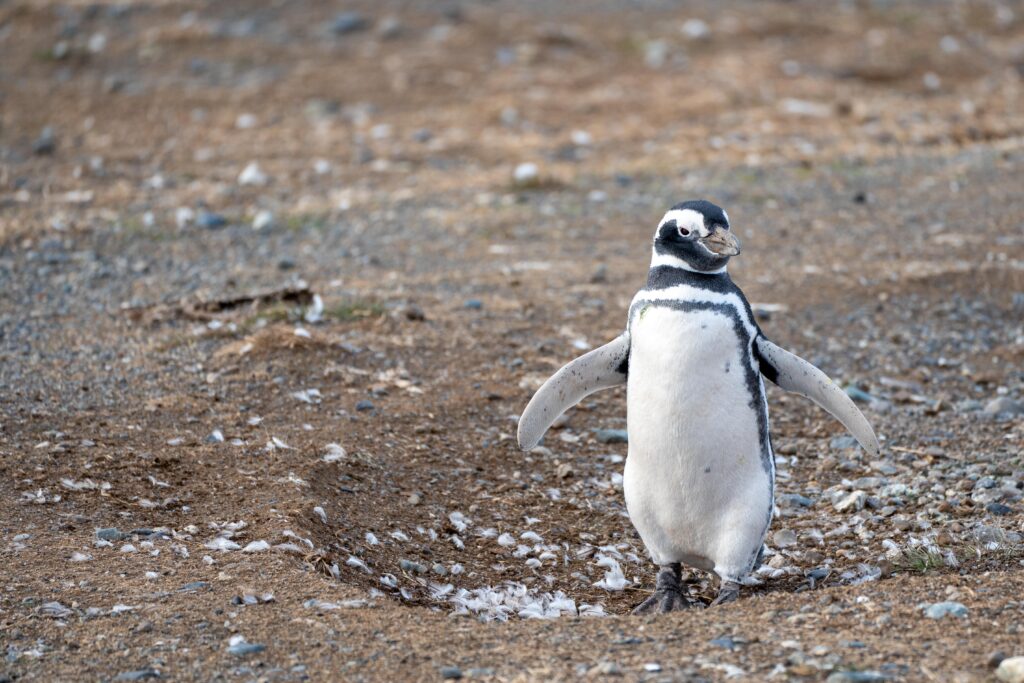RMF’s last country and the gateway to Antarctica
In the two days leading up to our arrival in Punta Arenas, many of our conversations revolved around whether RMF would be admitted into Chile, and therefore complete his UN countries, or not. As we had learned from our guide in El Calafate, the inflexibility of Chileans was notorious in South America, and provided the only obstacle to entry. Unlike the other three crew members, RMF was unable to complete the mandatory Vaccine verification and as such, his entry into the country was still hanging in the ropes due to bureaucratic procedures.
Similar to his mood prior to jumping out of the plane in Buenos Aires, you could asses his state of mind by the fact that he become more reserved and quiet as we approached Chile and the moment of truth. Luckily for every one involved, we actually had a very smooth entry procedure. The handler, Julio, did a fantastic job and even sorted the immigration procedure while we were at the hotel (once again, the system was down…..).
Punta Arenas, with its location right on the Magellan straight, has been historically used as a re-supply Harbour for ships passing through the southern tip of South America or the Drake’s passage. In modern times, it has become a transit city for many on their way to Antarctica. This is felt throughout the place, as the infrastructure is mostly run down, there are not that many things to do inside the city and the choice of restaurants in limited. Luckily, we found a steak house and a burger place, both of which we frequented twice in our time here.
Punta Arenas, for us, was also the starting point for our King George Island (Antarctica) day trip. As the weather is notoriously unpredictable in Antarctica, we had planned in some time that we would spend in Punta Arenas. Over the past couple of days, most of us had started to become slightly sick. Therefore, we welcomed the down days that the bad weather provided, and outside of the Antarctica Briefing on Monday evening, rested and relaxed during out time here.
While the city itself does not have much to offer, the surrounding areas (with a lot of driving), do offer some potential for wildlife activities. On Wednesday morning, we went on a tour to Isla Magdalena, a small island in the Magellan straight that is home to up to 20,000 Magellan penguins. After 1h30 if transport, we arrived at the island, where we had about an hour or so to spend amongst the penguins. Cedric and I took the opportunity to take as many photos of the animals that we could. On return, we also made a brief stop at a Sea Lion Colony, which we could admire from the boat.
After three down days, weather related, it cleared up and it seemed that we would be able to enter Antarctica.
Chile, officially the Republic of Chile, is a country in the western part of South America. It occupies a long, narrow strip of land between the Andes to the east and the Pacific Ocean to the west. Chile covers an area of 756,096 square kilometers (291,930 sq mi), with a population of 17.5 million as of 2017. Chile is the southernmost country in the world, the closest to Antarctica, and share land borders with Peru to the north, Bolivia to the north-east, Argentina to the east, and the Drake Passage in the far south. Chile also controls the Pacific islands of Juan Fernández, Isla Salas y Gómez, Desventuradas, and Easter Island in Oceania. It also claims about 1,250,000 square kilometers (480,000 sq mi) of Antarctica under the Chilean Antarctic Territory. The country’s capital and largest city is Santiago, and its national language is Spanish.
Spain conquered and colonized the region in the mid-16th century, replacing Inca rule, but failing to conquer the independent Mapuche who inhabited what is now south-central Chile. In 1818, after declaring independence from Spain, Chile emerged in the 1830s as a relatively stable authoritarian republic. In the 19th century, Chile saw significant economic and territorial growth, ending Mapuche resistance in the 1880s and gaining its current northern territory in the War of the Pacific (1879–83) after defeating Peru and Bolivia. In the 20th century up to the 1970s Chile saw a process of democratization, rapid population growth and urbanization and increasing reliance on exports from copper mining for its economy. During the 1960s and 1970s, the country experienced severe left-right political polarization and turmoil. This development culminated with the 1973 Chilean coup d’état that overthrew Salvador Allende’s democratically elected left-wing government and instituted a 16-year right-wing military dictatorship of Augusto Pinochet that left more than 3,000 people dead or missing. The regime ended in 1990 after a referendum in 1988 and was succeeded by a center-left coalition which ruled until 2010.
Chile is a developing country with a high-income economy and ranks 43rd in the Human Development Index. It is among the most economically and socially stable nations in South America, leading Latin America in rankings of competitiveness, per capita income, globalization, state of peace, economic freedom, and low perception of corruption. Chile also ranks high regionally in sustainability of the state, democratic development, and has the lowest homicide rate in the Americas after Canada. It is a founding member of the United Nations, the Community of Latin American and Caribbean States (CELAC) and the Pacific Alliance, and joined the OECD in 2010.
Reference: Wikipedia.org under https://en.wikipedia.org/wiki/Chile
